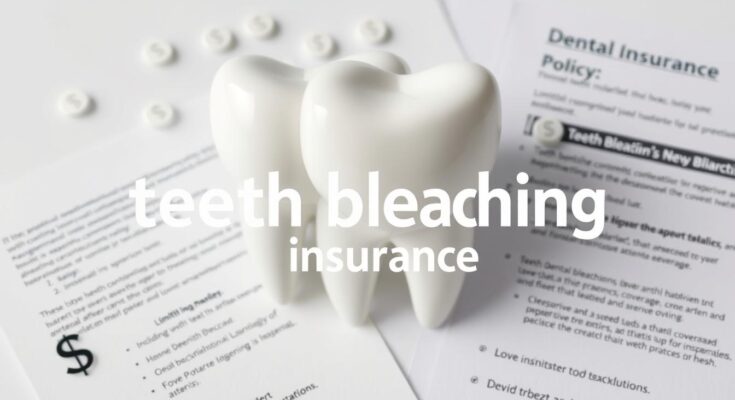Many people want a brighter smile and turn to teeth bleaching. But, did you know dental insurance might help pay for it? This guide will cover insurance options, what’s covered, and how to get the most out of your benefits for a brighter smile.
Key Takeaways
- Understand the different types of teeth whitening procedures and their insurance coverage options.
- Learn about common insurance terms and definitions related to teeth bleaching treatments.
- Discover the differences between professional and at-home teeth whitening treatments and their respective insurance coverage.
- Explore the cost analysis of professional teeth whitening and how insurance can help offset the expenses.
- Identify insurance plans that specify cover teeth bleaching procedures and the associated coverage details.
Understanding Teeth Bleaching and Insurance Basics

Teeth whitening and dental insurance can seem complex. There are many options, from in-office treatments to at-home kits. Knowing the basics helps you choose wisely and use your dental benefits well.
Different Types of Teeth Whitening Procedures
Teeth whitening falls into two main categories:
- Professional whitening, done by a dentist, uses special tools and strong agents for quick results.
- At-home kits, like strips and gels, are cheaper and easier to use for a brighter smile.
Common Insurance Terms and Definitions
Understanding dental insurance terms is key. You’ll come across:
- Deductible: The upfront cost before insurance starts covering.
- Copayment: A fixed cost for a service, like a dental visit.
- Coinsurance: Your share of the cost for a covered service.
Professional vs. At-Home Treatments
Choosing between professional and at-home whitening depends on what you want. Professional treatments offer quick, lasting results but cost more. At-home options are cheaper but may not be as effective or long-lasting.
| Feature | Professional Whitening | At-Home Whitening |
|---|---|---|
| Effectiveness | Highly effective, producing dramatic results | Moderately effective, with gradual improvements |
| Convenience | Requires multiple dental visits | Can be done at home on your own schedule |
| Cost | Generally more expensive | More affordable |
Knowing the differences helps you choose the best option for your needs, budget, and insurance.
Teeth Bleaching Insurance Coverage: What You Need to Know
Understanding oral health insurance can be tricky, specially when it comes to teeth bleaching. Knowing what your insurance covers is key if you want to whiten your teeth.
Most dental insurance plans don’t cover teeth whitening because it’s seen as cosmetic. But, there are times when insurance might help pay for it.
- Medical Necessity: If a dentist says whitening is needed for health reasons, like discolored teeth from medicine, insurance might help.
- Pre-existing Conditions: Some plans won’t cover whitening if you already have discolored teeth. They might say it’s not covered.
- Policy Limits: Even if whitening is covered, there might be limits. This could be a yearly cap or a limit on how many times you can get it done.
It’s wise to check your dental insurance policy and talk to your dentist. They can explain what cosmetic dentistry, like teeth bleaching, is covered. This helps you pick the best choice for your smile and budget.
“Navigating the complexities of dental insurance can be daunting, but understanding the nuances of coverage for teeth whitening is critical for those seeking a brighter smile.”
Coverage Limitations and Exclusions for Cosmetic Dentistry

Dental insurance plans have rules for cosmetic dentistry, like teeth bleaching. Some plans offer limited benefits for these treatments. But, many have strict rules that limit their use.
Medical Necessity vs. Cosmetic Enhancement
Insurance coverage depends on if a treatment is medically necessary or just for looks. Plans usually cover things like fillings and root canals. But, cosmetic treatments like whitening teeth are often not covered or have strict rules.
Documentation Requirements for Coverage
- To get coverage for teeth bleaching, you might need to show dental records and treatment plans. This proves the procedure is medically needed.
- Insurance companies might ask for approval before they cover cosmetic dentistry services.
Pre-existing Condition Clauses
Pre-existing conditions can also affect coverage for cosmetic dentistry. Some plans might not cover or limit benefits for conditions or stains that were there before you got the policy. This can make it hard to get coverage for whitening teeth in some cases.
| Dental Insurance Plan | Coverage for Teeth Whitening | Limitations and Exclusions |
|---|---|---|
| Plan A | Limited coverage | Requires prior authorization, excludes pre-existing conditions |
| Plan B | No coverage | Considered a cosmetic procedure, not medically necessary |
| Plan C | Partial coverage | Limited to a certain number of treatments per year |
It’s key to know the rules for cosmetic dentistry, like teeth bleaching, when picking a dental insurance plan or getting treatment. Knowing these details helps patients make better choices and get the most from their insurance for these services.
Cost Analysis of Professional Teeth Whitening
Professional teeth whitening can change your smile for the better. But, the cost can vary a lot. It’s key to understand these costs before deciding.
In the U.S., the average cost for professional teeth whitening is between $300 and $1,000 per session. Several things can affect the price. These include the whitening method, the dentist’s location, and the case’s complexity.
| Teeth Whitening Treatment | Average Cost |
|---|---|
| In-office Bleaching | $500 – $1,000 |
| Take-home Whitening Trays | $300 – $600 |
| Zoom! Whitening | $500 – $800 |
Insurance coverage for teeth bleaching costs and professional teeth whitening varies a lot. Some plans might cover part of the cost. Others might not cover it at all, seeing it as cosmetic.
“When it comes to professional teeth whitening, the price can be a significant factor, but it’s important to weigh the long-term benefits of a brighter, more confident smile.”
To get the best deal, research and compare teeth bleaching costs and professional teeth whitening in your area. Talking to a trusted dentist can also help. They can guide you to the best and most affordable option for your smile.
Insurance Plans That Cover Teeth Bleaching Procedures

Many dental insurance plans cover teeth bleaching. It’s important to know the differences to pick the best one for you.
PPO vs. HMO Coverage Options
PPO plans let you choose your dentist and may cover cosmetic procedures like teeth whitening. HMO plans are stricter and only cover teeth bleaching if it’s medically necessary.
Specialized Dental Discount Programs
Some companies offer dental discount programs for teeth whitening. These can be cheaper than traditional insurance, if your plan doesn’t cover cosmetic procedures.
Annual Maximum Benefits
It’s key to know your plan’s annual maximum benefits for teeth bleaching. Insurance plans have limits on how much they pay each year, affecting the cost of whitening.
| Insurance Plan Type | Teeth Whitening Coverage | Annual Maximum Benefits |
|---|---|---|
| PPO | May cover some cosmetic procedures | Varies, typically $1,000 – $2,000 |
| HMO | Usually only covers medically necessary procedures | Varies, typically $1,000 – $2,000 |
| Dental Discount Program | Provides discounts on cosmetic procedures | No annual maximum, but discounts may be limited |
Understanding your dental whitening benefits can help you use your dental insurance plans wisely. This way, you can get the smile you want.
Alternative Payment Options for Teeth Whitening
When your dental insurance doesn’t cover the full cost of teeth bleaching, there are other ways to pay. These options can help you manage the costs and make the treatment more affordable.
Using a health savings account (HSA) or flexible spending account (FSA) is a good idea. These accounts let you save pre-tax dollars for medical expenses, including teeth whitening.
Dental discount plans are another option. They offer lower rates on dental services like teeth bleaching for a monthly or yearly fee. This can be a budget-friendly choice, if you don’t have full dental insurance.
Many dental offices also have financing plans or work with lenders. These plans let you pay for teeth whitening over time. They often have low or no-interest rates, making it easier to afford.
Exploring these payment methods can make teeth whitening more accessible, even without insurance. By looking into these options, you can find a way to fit the treatment into your budget and dental needs.
“Maintaining a bright, white smile can have a significant impact on one’s confidence and overall well-being. These alternative payment options make it easier for more people to access this transformative dental treatment.”
How to Submit a Claim for Teeth Bleaching
Getting insurance for teeth bleaching can seem tough. But with the right steps, you can get your claims approved. Here’s how to submit a claim for teeth bleaching insurance coverage.
Required Documentation
You’ll need some documents to make your claim smooth. These include:
- A detailed description of the teeth whitening treatment performed, including the specific procedures and products used
- A copy of the treatment plan and cost breakdown provided by your dental professional
- Proof of payment for the teeth bleaching services
- A letter from your dentist explaining the medical necessity of the treatment, if required by your insurance provider
Appeal Process for Denied Claims
If your claim is denied, don’t worry. You can appeal the decision. First, understand why it was denied. Then, gather more evidence to support your claim. Insurance companies have rules for appeals, so know them well.
Reimbursement Timeline
How long it takes to get your money back varies. It usually takes 2 to 6 weeks. But sometimes, it can take longer. Stay in touch with your insurer to make sure your claim is processed fast.
Knowing about teeth bleaching insurance can help you get the most from your dental benefits. By following the right steps and documenting your claims well, you can get the coverage you need for your teeth whitening.
Comparing Insurance Providers and Their Whitening Benefits
Dental insurance for teeth whitening varies a lot. Different providers offer different benefits, limits, and costs. Let’s look at how big insurers compare for teeth bleaching coverage.
| Insurance Provider | Whitening Coverage | Limitations | Average Cost to Patient |
|---|---|---|---|
| Aetna | Covers in-office whitening only | Limited to once every 5 years | $150 – $300 |
| Delta Dental | Covers both in-office and at-home whitening | Frequency limits vary by plan | $100 – $400 |
| MetLife | Covers in-office whitening only | Limited to once per lifetime | $250 – $500 |
| UnitedHealthcare | Does not cover any teeth whitening procedures | N/A | Full cost paid by patient |
The dental insurance plans and dental whitening benefits differ a lot. It’s key to check your plan’s details. This way, you know what’s covered for professional teeth bleaching.
“Understanding your dental insurance coverage for teeth whitening is key to avoiding unexpected costs and maximizing your benefits.”
Maximizing Your Dental Benefits for Teeth Whitening
Understanding teeth bleaching insurance coverage and oral health insurance is key. It helps you get the most from your dental plan for teeth whitening. This way, you can get a bright, confident smile without spending too much.
Timing your teeth whitening is smart. Many plans have a yearly limit. Scheduling your whitening at the end of the year can use up all your funds. Also, pairing whitening with cleanings or exams can make the most of your plan.
- Time your teeth whitening treatments towards the end of your annual coverage period
- Combine teeth whitening with other covered dental services to maximize benefits
- Review your plan’s details to understand any specific coverage limitations or exclusions for cosmetic dentistry
It’s also vital to know what your plan covers for teeth whitening. Some plans might cover part of professional whitening, while others might not cover cosmetic treatments at all. Always check your plan and talk to your dentist to make sure you’re using your teeth bleaching insurance coverage wisely.
Being informed and proactive can help you use your oral health insurance well for teeth whitening. With the right planning and knowledge of your coverage, you can get a healthy smile. And you’ll spend less money on it.
Conclusion
Understanding dental insurance for teeth bleaching can be tough. But, with the right information, you can get the most out of your coverage. Knowing about different whitening methods and insurance terms is key. Also, looking into other payment options helps ensure you get the coverage you deserve.
Choosing between in-office treatments or at-home kits depends on your needs and budget. Working with your dentist is vital. They can help you find the best option for you. Knowing about coverage limits and how to appeal can also help you make smart choices.
By using your teeth bleaching insurance coverage and looking into dental whitening benefits, you can get a brighter smile. This doesn’t have to cost a lot. With determination and the right steps, you can overcome dental insurance challenges and get the smile you want.
FAQ
What types of teeth whitening procedures are covered by dental insurance?
Dental insurance usually covers professional teeth whitening done in a dentist’s office. It rarely covers at-home kits or products you buy yourself.
How is teeth bleaching viewed by insurance providers?
Insurance companies often see teeth whitening as a cosmetic treatment. This means it’s not seen as medically necessary. So, it’s often not covered by standard plans.
What factors influence whether teeth bleaching will be covered by insurance?
Several things affect if insurance will cover teeth whitening. These include why you need it, your dental history, and your insurance plan’s rules. Also, if you have any pre-existing conditions or need to prove it’s necessary.
How can I maximize my dental insurance benefits for teeth whitening?
To get the most from your insurance, plan your whitening treatments for when your plan’s annual limit is high. Look into dental discount programs and consider using Health Savings Accounts (HSAs) or Flexible Spending Accounts (FSAs) for extra help.
What is the typical cost of professional teeth whitening, and how can insurance help?
Professional teeth whitening can cost anywhere from $300 to over $1,000. If your insurance covers it, it can help lower what you have to pay out of pocket.
How do I submit a claim for teeth bleaching and what should I expect?
To file a claim, you’ll need to give your insurance all the necessary documents. This includes treatment records and proof that it was medically necessary. Be ready for the chance that your claim might be denied and know how to appeal. How long it takes to get your money back can vary too.
How do different dental insurance plans compare in terms of teeth whitening benefits?
Dental insurance plans can have very different benefits for teeth whitening. PPO plans might offer more than HMO plans. You can also look into dental discount programs for other ways to save.



